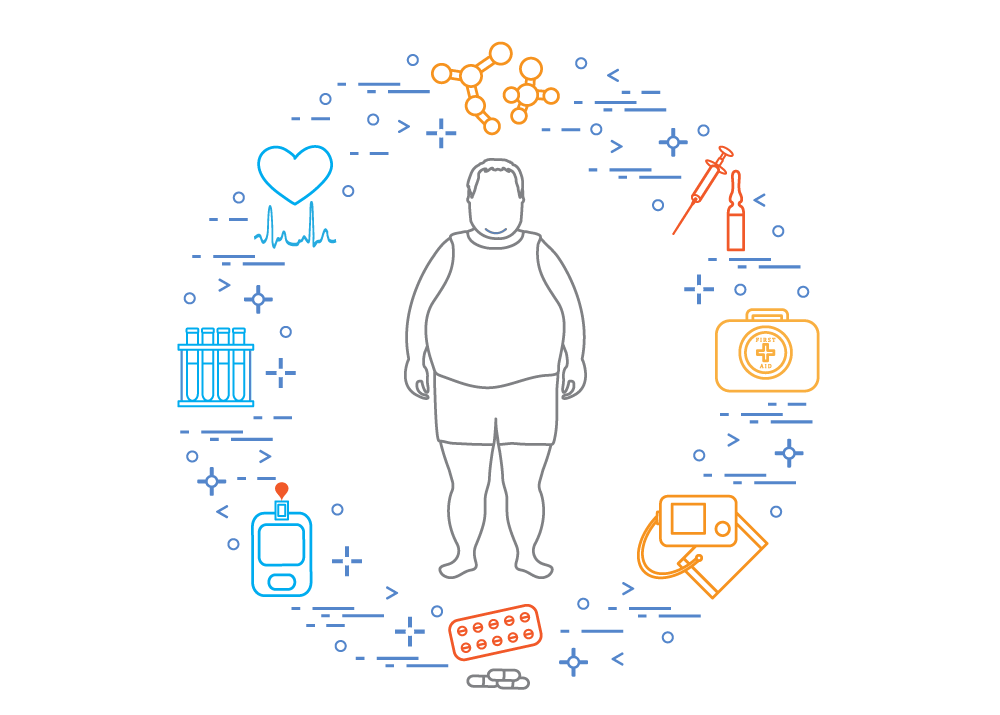Pharmacy schools can help address the nation’s obesity crisis by incorporating competencies into the curriculum.
By Emily Jacobs
Despite public health efforts at all levels of government, obesity continues to be a serious issue in the United States. Defined as having a body-mass index (BMI) of 30.0 or higher, obesity has been linked to numerous chronic health conditions, including diabetes, cardiovascular disease and hypertension, according to the Centers for Disease Control and Prevention. Obesity affected 42.4 percent of U.S. adults in 2017–18.
Various providers may find opportunities to address obesity among patients because it can have such wide-ranging effects on health. However, many health professionals have not been trained to talk about obesity effectively, partly due to a lack of standardized obesity education. Improved education and training could help medical students and healthcare professionals better communicate with their patients about obesity.
This has created a need for health professions educational institutions to include obesity training in their curricula. The Provider Competencies for the Prevention and Management of Obesity aim to address this need. These competencies are the interdisciplinary creation of the Provider Training and Education Workgroup of the Integrated Clinical and Social Systems for the Prevention and Management of Obesity Innovation Collaborative, an ad hoc activity associated with the Roundtable on Obesity Solutions at the National Academies of Sciences, Engineering, and Medicine that culminated in a Robert Wood Johnson Foundation funded project via the Miliken School of Public Health at George Washington University.
“It was an incredibly collaborative, positive group, recognizing that we all had our different areas of primary competence,” said Dr. Jan Kavookjian, associate professor of health outcomes research & policy at Auburn University Harrison School of Pharmacy (HSOP), and member of the interprofessional panel selected to develop the competencies. “We were trying to generate broad competencies in specific categories that would make them relevant across health professions.”
The workgroup created a list of 10 competencies that emphasize the need to approach obesity as a disease. The competencies also note that collaboration among health professionals can help achieve better results for patients and practitioners alike. Practices should have safety accommodations specific to individuals carrying extra weight. The competencies also emphasize the use of evidence-based care for individuals with obesity, obesity risk or obesity comorbidities. Providers are also encouraged to minimize biases or discrimination against individuals with obesity and use person-centered communication.
These competencies are not meant as a stand-alone set or curriculum; they can be integrated into current curricula or used to create new curricula. Obesity competencies are intended as general concepts for obesity knowledge, obesity care or prevention and weight-related patient interactions. Competencies are meant to provide a common language for clinical experiences involving obesity. Several health professions education institutions across the nation are incorporating these competencies into their curricula.
An Opportunity for Pharmacy Schools
The gap in knowledge regarding obesity management presents an opportunity for pharmacy schools. By implementing obesity competencies into the curricula, colleges of pharmacy can help train future pharmacists to address the obesity crisis within their communities. At Auburn University, HSOP leaders have developed an integrated Pharm.D. professional curriculum, with an aim to create a “Practice Ready Graduate.” This curriculum prepares student pharmacists to deliver both pharmacological and nonpharmacological obesity management services in community-based settings. This includes an introduction to obesity as a disease and the impact of lifestyle changes and pharmacological approaches.
HSOP’s curriculum also gives students training in providing direct patient care, thus expanding the role of the pharmacist beyond dispensing medications. For example, in their fourth year, student pharmacists rotate through HSOP’s two on-campus pharmaceutical care clinics. This provides experience in patient care activities, including caring for persons with obesity. Students deliver counseling under the Healthy Habits Weight Management Program and conduct biometric screenings for university employees as part of the award-winning Healthy Tigers Wellness Program.
While HSOP first developed its “Practice Ready Graduate” vision in 2014, it began transitioning to a new, competency-based curriculum in the 2017 fall semester. This incorporates many of the obesity competencies developed by the Collaborative. Other pharmacy schools have expressed interest in applying this approach to varying degrees to their curricula.
Dr. Margarita DiVall, associate dean for faculty affairs, diversity, equity and inclusion, Northeastern’s Bouvé College of Health Sciences, supports incorporating obesity competencies into the curriculum, especially given that obesity is a major risk factor for many chronic diseases. “It’s critical for us to educate our pharmacy students about obesity, particularly because it disproportionately affects people of color and those with lower socioeconomic status,” DiVall said. “While treatment can include pharmacological agents, it is also important to instruct students on nutrition and lifestyle factors that impact obesity and to teach them about the role they play on an interdisciplinary team. They need to know everybody’s role, including the role of the pharmacist, and how to work with the team on identifying the right time for implementation of pharmacological agents. In our curriculum, we talk about obesity as a risk factor for many chronic diseases and have specific time dedicated to the topics of obesity epidemiology, racial and ethnic disparities, prevention and management.”

